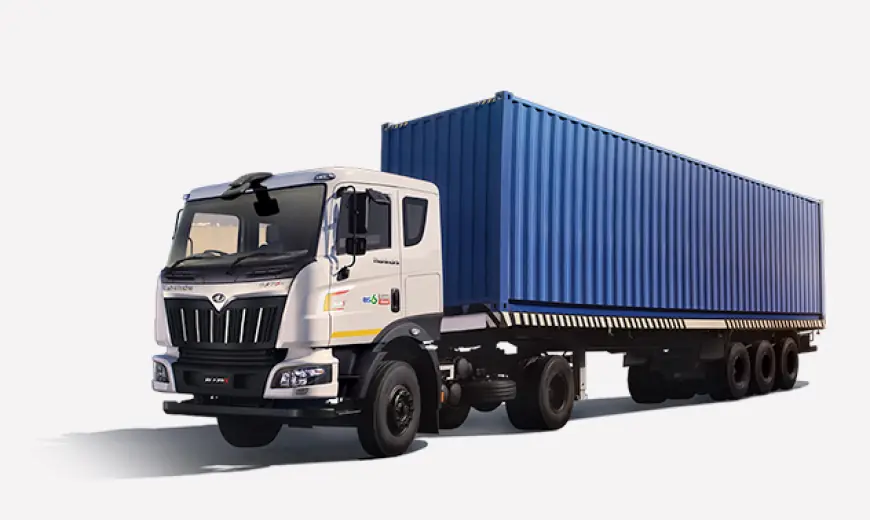Saudi Arabia Heavy-Duty Trucks Market 2030F Demand Forecast
Saudi Arabia's rapid and large-scale infrastructure development is a significant factor driving the demand for heavy-duty trucks.

The Saudi Arabia Heavy-Duty Trucks Market is undergoing rapid expansion as the Kingdom strengthens its logistics and transportation ecosystem. According to TechSci Research, the market was valued at USD 8.15 billion in 2024 and is projected to reach USD 11.89 billion by 2030, growing at a CAGR of 6.50% during the forecast period. This growth is closely tied to Saudi Arabia’s ambitious Vision 2030 strategy, which emphasizes economic diversification, infrastructure modernization, and logistics optimization.
Heavy-duty trucks, essential for construction, mining, freight movement, and industrial logistics, are experiencing rising demand due to increasing trade volumes, large-scale infrastructure projects, and expanding e-commerce operations. As the Kingdom strengthens its position as a regional logistics hub, the demand for efficient, durable, and technologically advanced trucks will continue to climb.
Industry Key Highlights
- Market Size & Growth: Valued at USD 8.15 billion in 2024, projected to hit USD 11.89 billion by 2030.
- CAGR: Robust growth rate of 6.50%, reflecting strong demand across sectors.
- Vision 2030 Impact: Heavy investments in infrastructure, logistics hubs, and industrial expansion driving market acceleration.
- Technology Adoption: Rising digitalization, telematics integration, and smart fleet management improving operational efficiency.
- Fuel Diversification: While diesel dominates, the push for electric and alternative fuel trucks is gaining momentum.
- Regional Leadership: The Eastern region leads in adoption, thanks to oil & gas dominance, ports, and industrial clusters.
- Fastest Growing Application: Freight & Logistics segment driven by e-commerce expansion and global trade routes.
- Global Players’ Presence: Strong competition from international OEMs like Mercedes-Benz, Volvo, ISUZU, Hyundai, and Tata Motors.
- Challenges: High upfront costs, limited electric infrastructure, and shortage of skilled maintenance labor.
- Future Opportunity: Advancements in autonomous driving, green fuels, and smart logistics integration.
Download Free Sample Report: https://www.techsciresearch.com/sample-report.aspx?cid=15521
Emerging Trends in Saudi Arabia Heavy-Duty Trucks Market
1. Digitalization and Telematics Adoption
Digital transformation is reshaping the truck industry in Saudi Arabia. Fleet management systems and telematics solutions are enabling real-time monitoring of vehicle health, driver behavior, and fuel consumption. Predictive maintenance powered by AI reduces downtime and ensures maximum truck utilization. Logistics companies are increasingly integrating telematics for route optimization, cost reduction, and safety compliance.
2. Electrification and Sustainable Mobility
Although electric trucks remain in the early adoption phase, Saudi Arabia is gradually moving toward greener transport solutions. Supported by government sustainability goals, investments in charging infrastructure and alternative fuels are expected to rise. Electric heavy-duty trucks, while currently expensive, promise lower lifecycle costs, reduced emissions, and energy efficiency, aligning with global decarbonization trends.
3. Autonomous and Semi-Autonomous Driving
The introduction of advanced driver-assistance systems (ADAS) and semi-autonomous features is boosting operational safety and efficiency. Technologies such as lane-keeping assist, adaptive cruise control, and collision avoidance systems are becoming standard in premium truck models. Over time, Saudi Arabia may adopt fully autonomous trucks, particularly in freight corridors and industrial zones.
4. Rising Demand from E-Commerce
Saudi Arabia’s e-commerce boom is fueling demand for last-mile and long-haul freight solutions. Logistics firms are expanding their heavy-duty fleets to cater to increasing consumer demand for fast deliveries. With new logistics hubs, warehouses, and smart distribution centers, the reliance on heavy-duty trucks is intensifying.
5. Alternative Fuel Innovation
Beyond electrification, Saudi Arabia is also exploring hydrogen-powered and natural gas trucks. Given the Kingdom’s vast energy resources and green hydrogen ambitions, hydrogen trucks could play a pivotal role in the future. This trend aligns with Vision 2030’s sustainability targets and the global push toward zero-emission transport.
Market Drivers
1. Strategic Geographic Location
Saudi Arabia is positioned as a gateway between Asia, Europe, and Africa, making it a central hub for international trade. Ports like Jeddah, Dammam, and Jubail are critical for global supply chains, creating a strong need for heavy-duty trucks for inland freight movement.
2. Vision 2030 and Infrastructure Growth
Massive investments in mega-projects such as NEOM, Red Sea Project, and Riyadh Metro require large fleets of heavy-duty trucks for construction materials and logistics. This has been a significant demand accelerator for the sector.
3. Growth of the Logistics Sector
The logistics market in Saudi Arabia is expanding rapidly, supported by e-commerce growth, rising consumer demand, and trade agreements. Companies are modernizing their fleets to enhance speed, reliability, and efficiency.
4. Industrial Expansion
Saudi Arabia’s diversification into manufacturing, retail, and mining sectors has created greater freight movement needs, further driving truck demand. Heavy-duty trucks remain the backbone of industrial supply chains.
5. Technological Advancements
With smart technologies becoming integral to fleet operations, businesses are increasingly investing in telematics, automation, and AI-driven logistics solutions to remain competitive.
Competitive Analysis
The Saudi Arabia Heavy-Duty Trucks Market is highly competitive, with both global OEMs and regional players vying for market share.
Key Players in the Market:
- Mercedes-Benz Group AG – Strong presence with advanced models focusing on durability and luxury.
- MAN Truck & Bus SE – Known for fuel-efficient and reliable fleets catering to logistics and construction.
- AB Volvo – Leader in technology integration, safety, and electric mobility innovations.
- ISUZU Motors International FZE – Popular for affordability and widespread availability.
- Hyundai Motor Company – Gaining traction with fuel-efficient trucks and expanding regional presence.
- PACCAR Inc. – Offers premium models with high durability and driver comfort.
- Tata Motors Limited – Competitive pricing and robust trucks suitable for the local market.
- Hino Motors, Ltd. – Strong in logistics fleet solutions with a focus on reliability.
- Mitsubishi Fuso Truck & Bus Corporation – Compact heavy-duty solutions suitable for urban freight.
- Ford Middle East – Leveraging its reputation for powerful trucks adapted to Saudi market needs.
Competitive Landscape Insights:
- Global brands dominate, leveraging advanced technology and strong after-sales support.
- Regional adaptation is critical, as players modify trucks to handle Saudi Arabia’s harsh desert conditions and high temperatures.
- Electric and alternative fuel trucks are emerging as competitive differentiators for forward-looking manufacturers.
Future Outlook
The future of Saudi Arabia’s heavy-duty truck market looks promising yet transformative. Key aspects of the future include:
- Accelerated Adoption of Electric Trucks – As charging infrastructure expands and battery costs fall, adoption will grow.
- Autonomous Trucking Trials – Semi-autonomous and fully autonomous trucks will begin pilot programs in logistics corridors.
- Integration with Smart Logistics – AI-powered supply chain optimization will boost efficiency.
- Expansion of Industrial Zones – New economic cities and industrial hubs will require stronger truck fleets.
- Government Incentives – Policies supporting green energy vehicles and modern fleet upgrades will encourage innovation.
By 2030, Saudi Arabia is expected to establish itself as one of the most advanced heavy-duty truck markets in the Middle East, driven by sustainability initiatives, technology adoption, and strategic investments in logistics.
10 Benefits of the Research Report
- Provides comprehensive market size and forecast data until 2030.
- Identifies emerging trends and innovations shaping the industry.
- Highlights key drivers and challenges influencing market growth.
- Offers competitive benchmarking of leading OEMs.
- Analyzes regional growth opportunities, especially in Eastern Saudi Arabia.
- Evaluates the impact of Vision 2030 on logistics and transportation.
- Provides insights on fuel diversification and electrification trends.
- Helps stakeholders align investment strategies with market opportunities.
- Covers detailed segmentation by tonnage, class, fuel type, and application.
- Equips decision-makers with data-driven insights to reduce risks.
Conclusion
The Saudi Arabia Heavy-Duty Trucks Market is on a strong growth trajectory, supported by economic diversification, industrial expansion, and logistics modernization. Despite challenges such as high vehicle costs and limited electric infrastructure, the long-term outlook remains highly positive. With global OEMs competing alongside regional players, the market is set for technological evolution, sustainability-driven transformation, and strategic growth.
Contact Us-
Mr. Ken Mathews
708 Third Avenue,
Manhattan, NY,
New York – 10017
Tel: +1-646-360-1656
Email: [email protected]
Website: www.techsciresearch.com
What's Your Reaction?
 Like
0
Like
0
 Dislike
0
Dislike
0
 Love
0
Love
0
 Funny
0
Funny
0
 Angry
0
Angry
0
 Sad
0
Sad
0
 Wow
0
Wow
0

















































